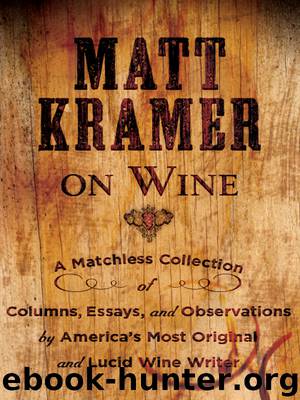Matt Kramer on Wine by Matt Kramer

Author:Matt Kramer
Language: eng
Format: epub
ISBN: 9781402783838
Publisher: Sterling Epicure
Published: 2010-09-06T16:00:00+00:00
A REVERED WINERY HAS LOST MORE THAN ITS LUXURY WINE HOLDINGS
“SO WHAT DO YOU MAKE of the Mondavi mess?” a fellow journalist asked me.
The story, in case you missed it, is that the Robert Mondavi Corporation, which is publicly traded, announced on September 14 [2004] that it was selling off its luxury wine holdings: the namesake Robert Mondavi Winery in Oakville, Arrowood Winery in Sonoma County, and Byron Winery in Santa Barbara County. Also on the block are its 50 percent ownership of three joint ventures: Opus One in Napa Valley, a partnership with Château Mouton Rothschild; Tuscany’s Ornellaia and Luce della Vite, a partnership with Marchesi de’ Frescobaldi; and Chile’s Seña, a partnership with Eduardo Chadwick.
Once stripped of this glossy veneer of brands and vineyards—which account for 14 percent of Mondavi’s case sales and 23 percent of operating revenue in fiscal 2004—the new entity will focus, as the company puts it, on “lifestyle” wines.
Lifestyle refers to the sub-$15 a bottle brands such as Woodbridge, Robert Mondavi Private Selection, La Famiglia, Papio, Arianna, Kirralaa, Hangtime, and Oberon. This is the meat and potatoes of the business, accounting for 86 percent of case sales and 77 percent of revenue. Actions quickly followed words: in late September, Mondavi laid off 360 employees, all of them at the Robert Mondavi Winery in Napa Valley.
Why is Mondavi doing this? Here’s the company line: “We believe that a lifestyle-focused company creates a new and unique business model with compelling future earnings growth, strong cash-flow generating capabilities, and relatively high financial returns, which provide an excellent profile for the investing public,” said the company’s president and CEO, Gregory M. Evans. “By contrast, because our luxury wine brands and assets are fundamentally agricultural in nature, with long-term investment horizons and lower financial returns over the next several years, they are better suited for a private entity that has different investment criteria.”
Napa Valley, it’s fair to say, is practically in mourning. Robert Mondavi, ninety-one, virtually invented fine California wine when he founded his namesake winery in 1966. He is the (gratefully) acknowledged messiah of the industry. Mr. Mondavi didn’t merely sail his own boat; he raised the tide itself. He’s given tens of millions of dollars to charitable causes, single-handedly created the Napa Valley Wine Auction event (itself a charity), and privately and discreetly offered money and assistance to numerous Napa Valley residents. Now you know why he’s revered.
But when the company went public in 1993, making the family wealthy, the die was cast. Mr. Mondavi’s two sons, Michael and Timothy, proved wanting as, respectively, CEO and winemaker, of the ever-larger operation. The family’s squabbles have been widely reported, and the wines themselves have been assailed in Wine Spectator and Robert M. Parker’s Wine Advocate as less than they should be. It’s not been a pretty sight.
So what really happened? It’s simple: the “suits” took over. “Suits” move boxes—wine-industry parlance for cases of wine. “Wine men,” in comparison, make wine. They never lose sight of what really counts, which is quality.
Download
This site does not store any files on its server. We only index and link to content provided by other sites. Please contact the content providers to delete copyright contents if any and email us, we'll remove relevant links or contents immediately.
| Buying Guides | Cellars |
| Champagne | Collecting |
| Spirits | Whiskey |
| Wine | Wine Pairing |
| Wine Tasting |
101 Whiskies to Try Before You Die by Ian Buxton(43934)
World's Best Whiskies by Dominic Roskrow(43898)
Whiskies Galore by Ian Buxton(41489)
Craft Beer for the Homebrewer by Michael Agnew(17902)
Right Here, Right Now by Georgia Beers(3886)
Not a Diet Book by James Smith(3125)
Water by Ian Miller(2934)
The Coffee Dictionary by Maxwell Colonna-Dashwood(2907)
Kitchen confidential by Anthony Bourdain(2770)
Coffee for One by KJ Fallon(2394)
Smuggler's Cove: Exotic Cocktails, Rum, and the Cult of Tiki by Martin Cate & Rebecca Cate(2322)
Beer is proof God loves us by Charles W. Bamforth(2232)
Talking as Fast as I Can by Lauren Graham(2231)
Superfood Smoothie Bowls: Delicious, Satisfying, Protein-Packed Blends that Boost Energy and Burn Fat by Chace Daniella(2219)
Bourbon: A Savor the South Cookbook by Kathleen Purvis(2113)
A Short History of Drunkenness by Forsyth Mark(2048)
Eat With Intention by Cassandra Bodzak(1984)
Colombia Travel Guide by Lonely Planet(1921)
Cocktails for the Holidays by Editors of Imbibe magazine(1912)
